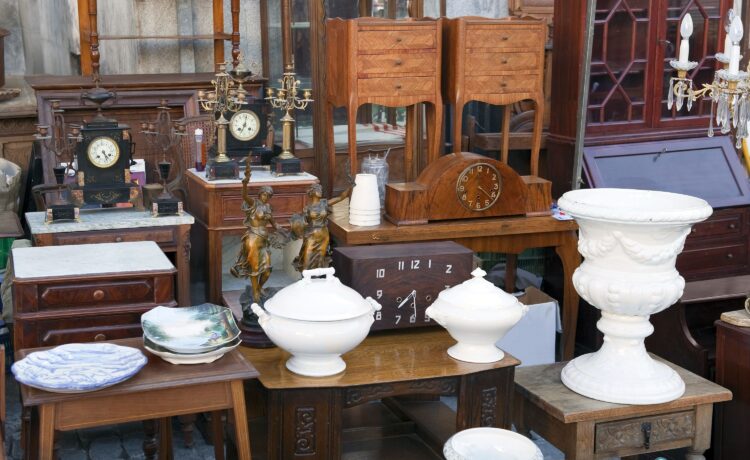Look around your room. Have you asked yourself how much your collectibles are worth? Knowing how to find the value of these items is important if you plan to sell, but it takes some practice. These are some tips to find out.
1. Identify Collectibles to Determine The Value
Learn as much as you can about the item. Take some time to examine them carefully. Look for identification marks, labels, or names. Note color, size, shape, pattern, and other unique characteristics that are important for antique identification. The more information you have, the better sense you will have about its value.
2. Research The Item
Visit local bookstores or libraries for more information about your piece. Look on eBay to see if there are any similar items found in their completed auction area. Visit online malls and selling venues like Etsy, Tias, Letgo, Facebook Marketplace, Craigslist, Replacements.com, and Ruby Lane. Look for collector clubs and dealers. Members will usually answer your questions for free.
3. Understand The Different Values of Collectibles
There are different kinds of monetary value associated with each item. Decide which type of value is needed:
- Retail. This is the price for which the item sells in a collectible or auction house.
- Wholesale. This is the price for which the dealer usually pays for the piece. This is around 33-50% less than the retail value.
- Fair market. This is the selling price of the item agreed upon by the seller and the buyer. Both parties must be aware of all information related to the item.
- Insurance. This is the highest monetary value given to an antique or collectible. This is also the cost of replacing the piece if destroyed or stolen.
- Tax. This is determined by averaging the auction price paid for a piece that is exactly the same or similar to the item.
- Auction. This is known as the open market price. This is the price the item would sell for when neither the seller nor the buyer is in the position for a forced sale.
4. Price Can Mean Different Things
Know these additional monetary values:
- The price the owner thinks the item is worth.
- The price the buyer would like to pay for the piece.
- The price is listed in a Price Guide.
- The actual price the items sell for, regardless if it was from an auction house, sold to a private buyer, or a dealer.
5. Consider The Criteria Used to Determine The Value of Collectibles
There are other factors used to determine the worth of a collectible.
- Trends and demand. Collecting trends change, so the demand for an item also changes. It can be more in demand, forcing prices to rise, or less in demand, causing prices to drop.
- Condition of collectibles. An item in good condition will always be worth more than a piece with damages. Look at your item and see if there are chips or cracks, paint loss or discoloration, or other types of wear and tear.
- Provenance. This is the history of an item, which is another important factor in determining its value. A documented history associated with someone famous will be worth more.
- The rarity of the collectible. Things that are rare are worth more than common ones. Mass-produced items can be found more easily, so they are worth less.
- Aesthetic appeal. Beauty matters in pricing your collectibles, especially when they are meant to be displayed. The more attractive it is, the more likely it will be worth more.
How Much Are Your Collectibles Worth?
It is very important to use a source that will give you current values. Some of them are:
- Auction selling prices.
- Online price guides.
- Written price guides.
- Appraisal services on and offline.
- Local antique and collectible dealers.
- Check recent auction selling prices. Online auction websites like eBay will provide a fairly accurate idea of the demand for your items. You can also see how much your collectibles are worth since you can browse for the same piece.
- Consult online price guides.One of the most popular is Kovels, which have more than 600,000 prices listed for antiques and collectibles. Other resources include the following:
- Beckett provides price guides for trading cards and other sports-related items.
- Downtown provides prices for back issues of collectible magazines.
- Collect provides current pricing for comic books, records, and militaria.
- Look at written price guides. These are available in books that focus on a specific type of antique. They are published annually to keep up with current market trends. Here are some examples:
- Kovels Antique and Collectibles Price Guide by Terry Kovel and Kim Kovel covers everything that you can imagine.
- Miller’s Collectibles Handbook & Price Guide by Judith Miller is another source for all types of collectibles.
- Beckett Baseball Card Price Guide by James Beckett for baseball card values.
- Use caution with valuation apps. The WorthPoint App has received mixed reviews from clients, saying technology doesn’t exist yet to give reliable values in a timely manner. It takes a long time to find your item, and the value may not be that accurate.
- Try professional appraisal services.These are available both online and offline. Generally, there is a fee to have items appraised. Have your items appraised locally to get the most reliable information on collectible pricing?
- Talk to local antique and collectible dealers.Drop by your local antique shop to ask someone for help. A lot of them can give you a professional opinion about your collectible’s value. They might also know someone in the area who’s a professional appraiser.
Blackwell Auctions is a fine art, vintage, and antiques auction house gallery in St Petersburg, Clearwater, Tampa Bay, Sarasota, Florida. Selling lots in-house and online, we’ve been carefully selecting distinctive items since 2016. In our gallery, you can expect to discover fine art, jewelry, firearms (FFL), militaria, coins, stamps, silver, memorabilia, and much more.
Contact Blackwell Auctions today for more information about the process of selling or consigning your valuables.













